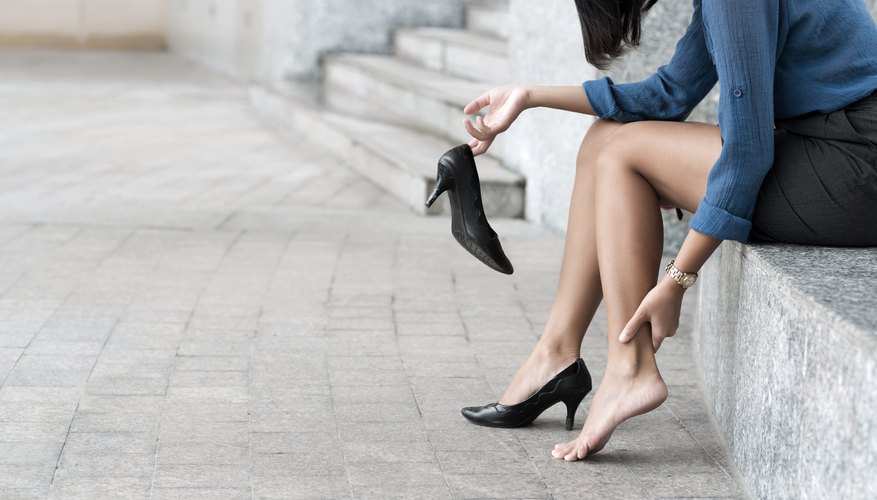How to Get Rid of Swollen Feet After Flying
Be "walk ready" with these travel-savvy tips

Swollen feet and ankles don't have to ruin the fun when you arrive at your destination. If you've ever experienced unpleasantly plump ankles at the end of a long flight, take heart. You can relieve the swelling, and it doesn't have to happen again. With these simple tricks, you'll be ready to hit your stride whether you're landing in New York, New Mexico or any other place where new adventures await.
How swollen ankles happen
Edema, a medical term for swelling of the ankles and legs, occurs when you sit still in one position for a prolonged period. In an airplane, you're more likely to sit quietly with your feet on the floor than at home or in the office where it's easier to stroll, fidget and shift positions frequently. Even if you are in tip-top health, fluid seeps into your lower extremities, causing them to swell a little, or a lot.
It's not a permanent condition, and it's rarely harmful, but edema can make walking uncomfortable until the swelling goes down. It can also make your shoes fit extra tight. You may even feel a little self-conscious because you don't have perfectly tapered legs to show off as you leave the arrivals gate at the airport. Don't worry unless there is excess swelling or pain beyond general discomfort, which can indicate a possible blood clot or deep vein thrombosis. In that case, seek medical attention promptly.
Help for swollen ankles
If you discover your ankles are swollen at the end of the flight, take a few moments to apply some tender, loving self-care:
- Rest and elevate. Find a place to sit with your feet up as soon as possible. Seating areas in the airline terminal will be the closest, and you can stretch out your legs on adjoining seats in an uncrowded area.
- Exercise. After a brief rest with your shoelaces loosened or your shoes completely off, begin gentle exercises. Rotate your ankles. Lift, lower and move your legs around. Finally, press the soles of your feet onto the ground and rock them while still seated. Put your shoes on and proceed to baggage claim and to your ground transportation, resting when necessary.
- Soak. At your destination, soak your feet for 15 to 20 minutes in a basin of tepid water and Epsom salts. Continue to alternate gentle exercise and rest with your feet elevated until the swelling subsides.
Preventing swollen ankles: before you fly
Put on clothing that fits loosely, and wear comfortable shoes for your flight. Do not wear knee socks or other socks with elastic bands that can restrict blood flow in your legs.
Drink plenty of water during the day before your flight. Avoid alcohol and sleep aids that might reduce your ability to safely move around the plane's cabin for bathroom and stretching breaks.
Take a baby aspirin just before boarding to support good circulation. Check with your doctor before you fly to make sure you're not at risk for bleeding and that the small, 81-milligram dose won't interfere with your other medications.
When you're on board
Place your carry-on luggage in an overhead bin so there's nothing blocking the area under the seat in front of you. Use that bonus space to rotate your ankles and wiggle your feet during the flight. Flex and release your calf muscles and thigh muscles occasionally to promote blood circulation in your legs.
Sip water frequently. Give alcoholic beverages, caffeinated drinks and salty snacks a pass as they can exacerbate swelling in your ankles – and the rest of your body, for that matter – during the flight.
Get up, walk up and down the aisle and gently stretch your body about every hour during longer flights. Always make sure the "fasten seat belt" sign is off, and check that in-flight service carts aren't blocking the aisle before you take your stroll.
How to use compression socks for prevention
If you are pregnant, recently had surgery or have other conditions that make you susceptible to swelling and poor circulation, your doctor may recommend wearing compression stockings when you fly. These garments fit snugly the entire length of your legs and help keep blood from pooling in your lower extremities. They can be difficult to put on. Practice before you fly. It's easiest to put compression socks on at home or in your hotel room before you head to the airport. Alternatively, you can pack the socks in your carry-on bag to put on after you pass through security but before you board your flight.
How to Get Rid of Swollen Feet After Flying
Source: https://getaway.10best.com/12782986/how-to-get-rid-of-swollen-ankles-after-flying